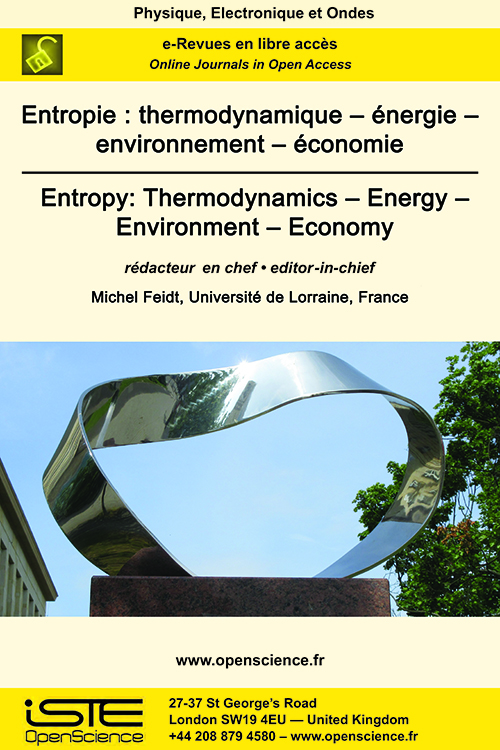

Physique > Accueil > Entropie : thermodynamique – énergie – environnement – économie > Numéro
The energy crisis, global warming, and rising energy consumption have positioned renewable energy as a priority from national and international planning perspectives. Not only to reach the goals of the renewable energy mix, but also as part of overall energy security strategy. Rising energy prices and supply concerns have made the need for energy changes tangible for society and have increased public awareness of renewable energy. To achieve its renewable energy targets, Ireland has placed a focus on the development of offshore wind energy projects, due to its massive potential in the region. Other regions have already commenced the deployment of large-scale offshore wind farms and the technology is now competitive with fossil fuels. This work presents a comparison of Geographic Information System (GIS) applications and Multi-Criteria Decision-Making (MCDM) methods applied in the process of multicriteria site selection for Floating Offshore Wind Farms (FOWF) and highlights current trends in FOWF site selection and characterisation. This work is an objective review of the methodologies applied by researchers and a discussion of their adequacy to find the answer to the research questions posed by industry. Furthermore, it outlines the limitations of the methods and comments on the chosen criteria in the context of reaching the researches objectives. It also highlights the suitability of the industry standards methods and best practices. Finally, the work attempts to map the next steps that shall be taken to improve the methodology for criteria selection.
La croissance exponentielle du nombre d’articles publiés annuellement dans le domaine des applications d’apprentissage automatique dans les systèmes énergétiques représente un défi pour les chercheurs cherchant à mener des revues de littérature exhaustives et efficaces. Pour répondre à cette problématique, nous avons adopté une approche systématique de revue de littérature avec trois études de cas distinctes se concentrant sur l’application de l’apprentissage automatique dans les systèmes énergétiques, à savoir : 1. L’apprentissage automatique dans le forage, 2. L’apprentissage automatique pour la quantification du potentiel énergétique solaire des toits, et 3. L’apprentissage automatique dans le chauffage urbain et le refroidissement dans le contexte du stockage saisonnier de l’énergie thermique. Dans chaque cas, nous avons utilisé une méthodologie de revue de littérature systématique. Pour le premier sujet, nous avons utilisé une revue complète existante pour générer de nouvelles perspectives et des informations supplémentaires. Pour les sujets deux et trois, nous avons utilisé des critères de recherche prédéfinis pour mener des publications pertinentes de manière systématique et reproductible. Nous étudions l’état de l’art de l’utilisation de l’apprentissage automatique dans ces domaines d’investigation distincts, facilitant ainsi l’identification des lacunes en recherche. En fin de compte, nous comparons les approches et les modèles utilisés dans chaque domaine, identifions les bonnes pratiques communes et proposons des méthodes pour relever les défis potentiels.
Adiabatic compressed air energy storage (A-CAES) is a promising storage technology to face the challenges of high shares of renewable energies in an energy system by storing electric energy for periods of several hours up to weeks. In order to reduce the investment costs and increase the flexibility of the storage system, the so called KompEx LTA-CAES® was developed by Fraunhofer UMSICHT. This new A-CAES concept is using a combination of reversibly operable turbo- and piston machines (KompEx machines). Doing so, these modules can achieve wide CAS pressure ranges (corresponding to high exergy densities) and thus can be combined with any compressed air storage volume. To realize efficient and stable operation despite a wide pressure range, a suitable control strategy of both KompEx machines is required. This paper investigates the introduced A-CAES system by a dynamic simulation, focusing on the interaction and synergy between the reversibly operable turbo- and piston machines. Results indicate that the roundtrip efficiency of this system is expected to be at the low end (55,5%) of literature values for A-CAES (52–66% for low-temperature A-CAES), which is relatively high compared to published A-CAES systems considering similar pressure ranges.
High-temperature heat pump (HTHP) is a promising technology for decarbonization of process heating through electrification and energy efficiency. Exploiting the potentials requires a simultaneous optimization of the cycle layout and the working fluid. This paper proposes an efficient cascade HTHP and optimizes its thermodynamic performance. Using steam for high-temperature loop and use of alternative hydrocarbons for low-temperature loop are examined. On the application level, district heating is considered as a heat source and evaluated for different supply temperatures, including 80 °C, 70 °C and 40 °C. The results reveal that pentane with highest critical temperature among the suggested hydrocarbons, shows the best energy performance to be paired with steam in the proposed cascade HTHP system. However, concerning the hydrocarbon compressor volumetric heating capacity (VHC) and safety issues, butane is an excellent candidate. In addition, when the heat available in the main transmission lines of district heating unit is considered as the source cooled from 80 °C down 70 °C, the highest value of coefficient of performance (COP) is achieved as 2.74 for the sink condensation temperature of 160 °C.

2025
Volume 25- 6
Numéro 12024
Volume 24- 5
Numéro spécial IEES2023
Volume 23- 4
Numéro 12022
Volume 22- 3
Numéro 12021
Volume 21- 2
Numéro 2 spécial SFT Prix Fourier2020
Volume 20- 1
Numéro 1